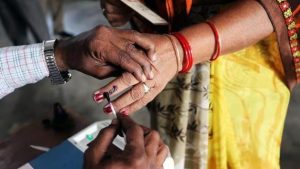Overview:
-
- Today, various legislation addresses social traditions and expectations that historically placed women in inferior positions.
- The Indian Constitution provides several safeguards for women’s rights, including provisions for equality, protection from sexism, and the right to life with dignity.
- While progress has been made, many women in India still face obstacles and discrimination in various areas of life.
- Women play an essential part in building nations; their empowerment is of utmost significance for everyone in society.
Gender inequality is a crucial problem that we must overcome. Despite the significant progress that women have made recently towards achieving equality, securing equal opportunities and receiving fair recognition remain a challenge.
“A world full of empowered women isn’t one where men are marginalized. It’s a world where everyone thrives.” —Purnima Mane.
Over time, women have brought about change in many spheres—economic, political, religious, social, and cultural. Slowly, women have gained some of the equal rights and opportunities they deserve, elevating their status in society.
But gender inequality continues, despite efforts to break the glass ceiling. This is a global issue in dire need of resolution. The path to the equality we have today has been long and difficult, and there is still much more to be done.

The Pervasive Prejudice: Women’s Unequal Position in Society
The continued inequality trend shows how many women have unknowingly adopted societal stereotypes and accepted their allotted responsibilities in the workforce and family life. Passed from generation to generation, widespread prejudice still prevails. Upward social mobility is challenging because of this prejudice, but unquestionably, women’s empowerment is something society would benefit from.
In India, the fight for independence in the twentieth century also marked the beginning of the fight for women’s equality. Different states formed their own laws, and the status of women varied as a result. There is no doubt that women in India have come a long way compared to the past. However, they still face many obstacles in our male-dominated society.
Progressive politicians have responded to political consciousness and the need for a more inclusive society with various legislation. They’ve seen the need to address the social traditions and expectations that have historically placed women in a position of inferiority. Much has changed thanks to recent generations of women who have fought discrimination. Women have regained their voice in the contemporary society formed in the twenty-first century, partly through gender laws that were created to empower them.
Indian culture, society, and politics have changed because of the women’s emancipation movement. In the nineteenth century, the movement saw limited success. But beginning in the twentieth century, Indian society witnessed significant momentum in the drive for women’s rights. Many female thinkers and leaders fought for women’s liberation. They secured numerous rights, especially in civil, criminal, and administrative matters. In addition, women have been given reservations in educational institutions, health services, and employment in different states of India.
A critical part of this change has been the evolution of men and women leadership styles in Indian society. As more women take on positions of power, their leadership styles challenge traditional norms and offer new perspectives on governance. Understanding these differences is the key to fostering inclusive environments and promoting gender equality in the decision-making processes.
Constitutional Safeguards
India is governed according to a set of fundamental principles in the Constitution. Every law the government passes must adhere to these principles since they outline people’s rights and obligations. Certain guidelines have been established with regard to women and their safety. The clauses that protect women’s rights are Articles 14 and 15, which guarantee equality and prohibit sexism. Regardless of sex, Article 16 provides equality of opportunity in public work. In Article 21, the Right to Life with Dignity has recently been added, which deals with the Right to Life and Personal Liberty. This aids in defending women’s rights to safe abortions, the ability to get a divorce, and to live their lives free from violence. And Article 51A was enacted to encourage peace and forbid demeaning behavior against women’s dignity.
Women in the Workplace
Women must be treated equally under Indian law, which forbids discrimination against them in all spheres of life, including employment, education, and career advancement. The law dictates that women should receive fair and appropriate career opportunities.
For example, labor laws have special measures for the health and safety of female employees. The law also stipulates that men and women must receive equal pay for jobs that are the same or substantially similar, to maintain equality. In terms of hiring, promotions, training, and transfers, discrimination against women is prohibited by the Equal Remuneration Act of 1976. Every employer is required by law to pay men and women the same salaries if they perform the same or equivalent jobs.
According to the Maternity Benefit Act, every woman is entitled to receive maternity benefits, including paid maternity leave. The purpose of this act, which was passed on December 12, 1961, was to control women’s employment in certain establishments during certain times before and after childbirth. The law protects women from losing their careers and source of income.
However, despite these legal protections, women continue to face barriers to their career advancement. For women in leadership challenges remain prevalent, as societal expectations often hinder their professional development. Women face biases that limit their access to high-ranking positions, and they are still underrepresented in leadership roles in many industries. Addressing these challenges requires not only stronger policies but also changing ingrained cultural attitudes towards women in the workplace.

The Sexual Harassment of Women at Workplace Act of 2013 is a law that provides a safe and hostile-free work environment for women. Effective implementation of the act will contribute to the realization of gender equality. A sense of security in the workplace will improve women’s workforce participation, resulting in economic empowerment and inclusive growth.
According to the law, POSH Act, “sexual harassment” includes unwanted sexually charged behavior expressed explicitly or implicitly. It also requires every office or branch of an enterprise with ten or more employees to have an “internal complaints committee” for hearing and resolving complaints of sexual harassment.
Marriage, Children, and Abuse (Sexual and Non-Sexual)
When a woman marries in India, she leaves her parents’ home and moves in with her spouse. Previously, women lost access to their parental homes after marriage, but this has changed legally.
According to the law, the husband and his family have a duty to support and maintain the wife. In this culture, most women become impoverished when financial support is cut off because of marital disputes. Since women are responsible for running the home, preparing meals for the family, and raising the kids, their chances of making money are severely limited.
Women in India now have the right to live in marital homes and claim maintenance for themselves and their children. Women also have the right to custody of their children. Still, many abused women continue to live in violent conditions and are unwilling to use the legal system because they fear losing custody. It was widely believed that children belonged to the father and a woman had no claim over them. But over time, legislation made it so that a woman is a joint primary guardian, which means she is the primary caregiver for her children.
Legal Reforms
This change came with the Protection of Women from Domestic Violence Act, which grants women the right to a life free of violence. It gives them the right to live in the same house and to claim maintenance, as well as the right to custody. Stridhan is also followed, in which women have a right to take all their belongings, even with the court’s help if needed.
Sexual violence is a significant issue that continues to affect many women. The Criminal Law (Amendment) Act, 2013 was updated to include rape and sexual offenses, as anti-rape campaigns were launched. The law includes offenses such as sexual harassment, disrobing, voyeurism, stalking, and rape. A person in a position of authority who rapes a woman under the age of 16, who cannot provide consent—especially if the victim gets pregnant—is considered to have committed a particularly heinous offense, despite exerting dominance through their authoritative status.

Similarly, the Protection of Children from Sexual Offenses Act was passed in 2012 to protect children from sexual assault and guarantee safety and care for sexual assault victims, while safeguarding the interest of the child at every stage of the judicial process. This law protects male and female minors under the age of 18. Any adult assaults a minor, whether a man or a woman, may be prosecuted under this act.
Before 1971, Section 312 of the Indian Penal Code (1860) made abortion a crime, except for situations where the procedure was required to preserve the woman’s life. In 1966, the Shah Committee made the compassionate and medically sound recommendation that abortion be made legal to safeguard women’s health and lives. Parliament passed the Medical Termination of Pregnancy Act in 1971.
Unfortunately, many families abuse the MTP Act’s provisions and get abortions for female fetuses—following the traditional preference for sons over daughters. This could eventually even lead to an unbalanced sex ratio. Procedures to determine the gender of the fetus were declared unlawful under this act’s 2002 amendment.
Recently, the Medical Termination of Pregnancy (Amendment) Act 2021 has been introduced to enhance the availability of safe and lawful abortion services based on therapeutic, eugenic, humanitarian and social reasons, with the aim of making comprehensive healthcare accessible to all.
Women & Law
The 1990 National Commission for Women Act established the National Commission for Women, founded in January 1992. Its duties include advising the government on all issues pertaining to women’s policy, reviewing Kanpur’s law, and intervening in or starting cases in the Supreme Court on these issues.
The Act was amended in 2019 to make provisions for enhancement of punishments for various offences so as to deter the perpetrators and ensure safety, security and dignified childhood for a child.
According to Article 15 (3) of the Constitution, which states that granting women greater protection is not discriminatory but will strengthen the concept of equality by assisting women in redressing historical wrongs, the legislature has the authority to pass special legislation for women.

A Call for Collective Action on Women’s Rights in India
“Freedom cannot be achieved unless women have been emancipated from all kinds of oppression.” —Nelson Mandela.
After independence, a number of laws and regulations were passed, as well as some important rulings that altered the trajectory of society. A handful of them also paid attention to gender issues and the need to improve the lives of women and other marginalized groups.
For the longest time, patriarchal society prevented women from speaking out and defending their rights. Violence against women is still prevalent in many parts of India. In rural areas, having a female child still causes chaos. The social structure is such that women still struggle to disclose cases of rape and molestation because they do not receive adequate support from their homes, communities, or government entities. The safety of women outside of their homes is constantly threatened. Ingrained attitudes, mindsets, and male entitlement still control the future of women in India.
Even when legislation is in place to protect women, traditions remain culturally prevalent. The objectives outlined in the constitution, laws, and policies and the reality of women’s status remain far apart. If we want to see laws improve the lives of Indian women, we should focus on critical areas of education, health care, and economic empowerment.
Without a doubt, women play an essential part in building nations. Thus, their empowerment is of utmost significance for everyone in society.
Conclusion:
To achieve true gender equality, it is crucial to change societal attitudes and perceptions towards women and their roles. The fight for women’s rights and empowerment in India is ongoing, and it is crucial for everyone to be a part of this effort.


